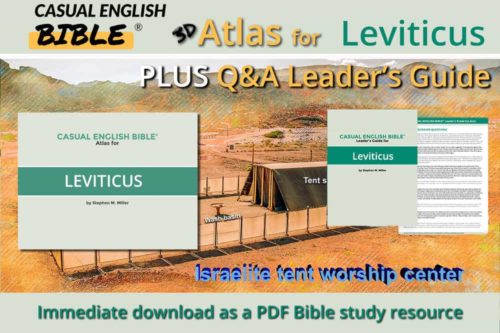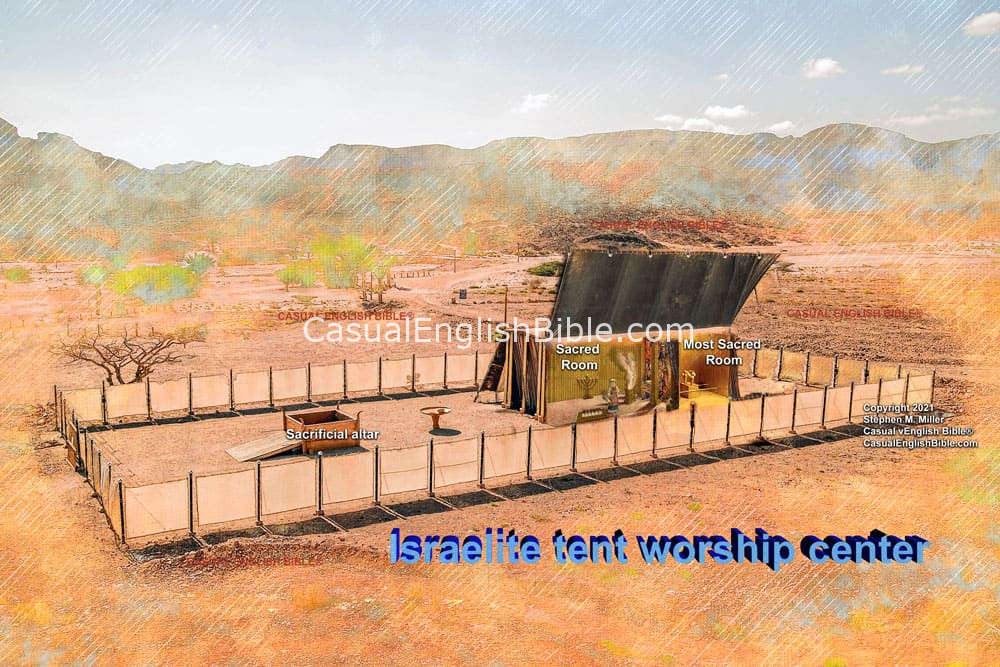Leviticus 1
How to sacrifice a burnt offering
Sacrificing bulls as a burnt offering
1The LORD talked to Moses in the Meeting Tent: [1] 2I want you to tell this to the people of Israel: When you sacrifice an animal as an offering to the LORD, use the livestock from your own herds or flocks.3If you’re going to sacrifice one of your cattle as a burnt offering, [2] pick one that’s healthy. It has to be a bull. And it has to be in good shape, and nothing wrong with it. Bring the bull to the entrance of the Meeting Tent. That’s where the LORD will accept your offering. 4Rest your hand on the head of the bull you’ll sacrifice. When you do this, the LORD will accept your offering. This sacrifice atones for your sins and puts you on good terms with God. [3]
5Kill the bull there on the LORD’s sacred site. Aaron’s sons, the priests, will splash some of the blood on all four sides of the altar that’s located near the Meeting Tent entrance. 6Skin the animal and cut it into pieces. 7Sons of Aaron the priest will put wood on the altar and start the fire. 8They’ll carefully place the animal onto the fire, piece by piece, including the head and the fat [4] from the kidneys and elsewhere. 9You’ll need to wash the animal’s legs and internal organs before burning them. The priest will burn the entire animal as an offering—a sweet smell to God.
Sacrificing sheep and goats
10If you plan to sacrifice a sheep or a goat, it has to be a male. And it can’t have anything wrong with it. 11Take the animal to the north side of the altar. Kill it there on this sacred site of the LORD. Aaron’s sons, the priests, will take some of the blood and splash it on all four sides of the altar.12Cut the animal into pieces, including the head and the fat. A priest will set them onto the fire on the altar. 13You’ll need to wash the animal’s internal organs and the legs before burning them. A priest will burn the entire animal as a burnt offering that rises as smoke—a sweet smell to God.
Sacrificing doves and pigeons
14If you plan to sacrifice a bird as a burnt offering, pick a dove or a pigeon. [5] 15The priest will take the bird to the altar and pop off its head. He’ll burn it as an offering that rises as smoke. But first he’ll drain the blood onto the side of the altar.16He’ll remove the undigested food from the bird’s crop sack [6] and toss it into the ash pile on the east side of the altar. 17Then he’ll hold the bird by its wings and tear it slightly open, without tearing it in two. He’ll put the bird on the fire as a burnt offering that rises as smoke—a sweet smell to God.
Footnotes
This is likely the tent worship center of Exodus 36-40, given the descriptions that come later, which include reference to the worship center’s altar (1:5). Yet some scholars say the Meeting Tent was not the tent worship center. The Meeting Tent was mentioned first in Exodus 33:7, before the tent worship center was built and located in the middle of the camp (Numbers 2:17). This was another place where Moses apparently spent some time, “outside the camp, at a fair distance” (Exodus 33:7). This is where people would go to hear from Moses about what the Lord had to say about any particular question they had. Some scholars say Moses likely set up this Meeting Tent outside the camp because of God’s refusal to travel with the people. Moses may have figured that if God wouldn’t come to them, they would go to God.
This was the most common animal sacrifice. Worshipers burned the entire animal.
Jews taught that in God’s eyes, sin was a capital offense. Jewish law, however, says God allowed them to substitute the death of an animal for the death they deserved. “Blood is what brings a body to life. I’ve given you blood to use exclusively on the altar. It atones for your sin—it gets rid of your guilt so you can stay on good terms with the LORD. Blood is the price of your sin” (Leviticus 17:11). The writer of Hebrews says the blood of Jesus was the last sacrifice needed; it paid the price for the sins of all people for all time (Hebrews 10:10).
Fat was considered the tastiest part of an animal—juicy and sweet.
Birds would have been the least expensive sacrifice, and perhaps all that the poorest Israelites could afford.
The crop sack is a small bag in the bird’s throat. Food softens there before moving into the stomach for digestion.
Discussion Questions
- 1
BY ROBERT V. HUBER
Leviticus tells us that three types of animals are appropriate for sacrificing to God when a person is asking for the forgiveness of his or her sins. They are cattle, sheep or goats, and pigeons or turtledoves. The animals should be perfectly healthy and uninjured and should generally be taken from the herds or flocks of the person offering the sacrifice. The idea of a sacrifice seems to demand that the petitioner give up something of value. Wild animals or imperfect animals are not acceptable. Why do you think these requirements are stressed?
- 2
The instructions for sacrificing various animals as burnt offerings repeat the same basic points: splash some of the animal’s blood on the altar, wash the animal’s parts in water, and burn the animal to send up a “sweet smell to God.” These steps are included for all types of animals, with variations only to suit the type of animal being discussed. What effect do you think the repetitions in these instructions have on readers?
- 3
God instructs the people through Moses to bring their animal sacrifices to the entrance of the Meeting Tent and to burn them on the altar there. The LORD will accept the offerings there because it is “sacred site of the LORD” (Leviticus 1:11). What’s the point of sacrificing animals in one central location when it was common throughout the region to build altars just about anywhere, as Abraham once did during his travels?
- 4
God says that Aaron’s sons should splash some of the sacrificed animal’s blood on the altar. Do you think he means Aaron’s sons literally? Or did he intend these procedures to continue throughout the centuries to come?
- 5
It was believed that the life of a person or animal resided in the blood. In offering a burnt sacrifice, God mandated that the priest should splash some of the animal’s blood on the altar. How is this blood related to the penitent petitioner, what had splashing it on the altar to do with him, and why did the priest (not the petitioner) do the splashing?
- 6
Instructions for all the burnt animal sacrifices call for the animal parts to be washed in water. Why would this be important?
- 7
LIFE APPLICATION. Given what the Israelites had to go through to be forgiven, how do you feel about the process of forgiveness today? And what do you think that process is?







